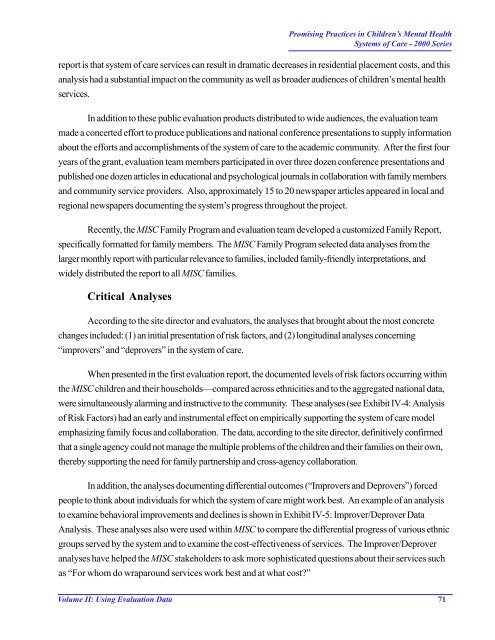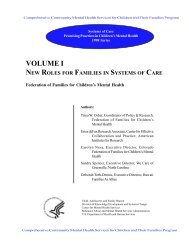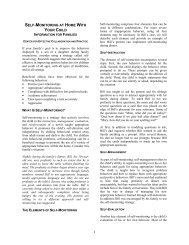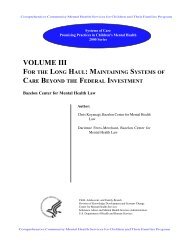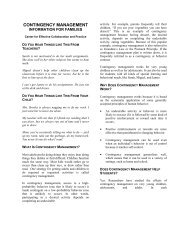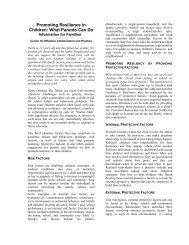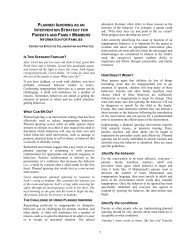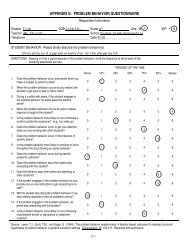Using evaluation data to manage, improve, market, and sustain ...
Using evaluation data to manage, improve, market, and sustain ...
Using evaluation data to manage, improve, market, and sustain ...
You also want an ePaper? Increase the reach of your titles
YUMPU automatically turns print PDFs into web optimized ePapers that Google loves.
Promising Practices in Children’s Mental Health<br />
Systems of Care - 2000 Series<br />
report is that system of care services can result in dramatic decreases in residential placement costs, <strong>and</strong> this<br />
analysis had a substantial impact on the community as well as broader audiences of children’s mental health<br />
services.<br />
In addition <strong>to</strong> these public <strong>evaluation</strong> products distributed <strong>to</strong> wide audiences, the <strong>evaluation</strong> team<br />
made a concerted effort <strong>to</strong> produce publications <strong>and</strong> national conference presentations <strong>to</strong> supply information<br />
about the efforts <strong>and</strong> accomplishments of the system of care <strong>to</strong> the academic community. After the first four<br />
years of the grant, <strong>evaluation</strong> team members participated in over three dozen conference presentations <strong>and</strong><br />
published one dozen articles in educational <strong>and</strong> psychological journals in collaboration with family members<br />
<strong>and</strong> community service providers. Also, approximately 15 <strong>to</strong> 20 newspaper articles appeared in local <strong>and</strong><br />
regional newspapers documenting the system’s progress throughout the project.<br />
Recently, the MISC Family Program <strong>and</strong> <strong>evaluation</strong> team developed a cus<strong>to</strong>mized Family Report,<br />
specifically formatted for family members. The MISC Family Program selected <strong>data</strong> analyses from the<br />
larger monthly report with particular relevance <strong>to</strong> families, included family-friendly interpretations, <strong>and</strong><br />
widely distributed the report <strong>to</strong> all MISC families.<br />
Critical Analyses<br />
According <strong>to</strong> the site direc<strong>to</strong>r <strong>and</strong> evalua<strong>to</strong>rs, the analyses that brought about the most concrete<br />
changes included: (1) an initial presentation of risk fac<strong>to</strong>rs, <strong>and</strong> (2) longitudinal analyses concerning<br />
“<strong>improve</strong>rs” <strong>and</strong> “deprovers” in the system of care.<br />
When presented in the first <strong>evaluation</strong> report, the documented levels of risk fac<strong>to</strong>rs occurring within<br />
the MISC children <strong>and</strong> their households—compared across ethnicities <strong>and</strong> <strong>to</strong> the aggregated national <strong>data</strong>,<br />
were simultaneously alarming <strong>and</strong> instructive <strong>to</strong> the community. These analyses (see Exhibit IV-4: Analysis<br />
of Risk Fac<strong>to</strong>rs) had an early <strong>and</strong> instrumental effect on empirically supporting the system of care model<br />
emphasizing family focus <strong>and</strong> collaboration. The <strong>data</strong>, according <strong>to</strong> the site direc<strong>to</strong>r, definitively confirmed<br />
that a single agency could not <strong>manage</strong> the multiple problems of the children <strong>and</strong> their families on their own,<br />
thereby supporting the need for family partnership <strong>and</strong> cross-agency collaboration.<br />
In addition, the analyses documenting differential outcomes (“Improvers <strong>and</strong> Deprovers”) forced<br />
people <strong>to</strong> think about individuals for which the system of care might work best. An example of an analysis<br />
<strong>to</strong> examine behavioral <strong>improve</strong>ments <strong>and</strong> declines is shown in Exhibit IV-5: Improver/Deprover Data<br />
Analysis. These analyses also were used within MISC <strong>to</strong> compare the differential progress of various ethnic<br />
groups served by the system <strong>and</strong> <strong>to</strong> examine the cost-effectiveness of services. The Improver/Deprover<br />
analyses have helped the MISC stakeholders <strong>to</strong> ask more sophisticated questions about their services such<br />
as “For whom do wraparound services work best <strong>and</strong> at what cost?”<br />
Volume II: <strong>Using</strong> Evaluation Data 71


